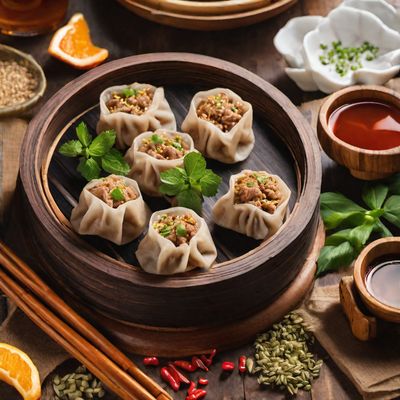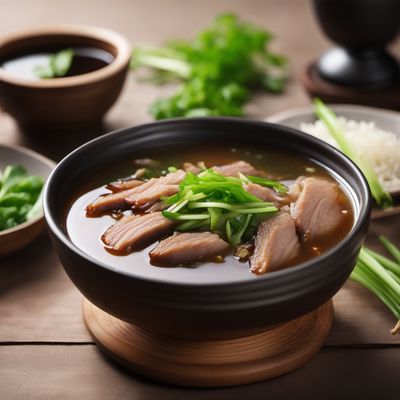
Ingredient
Soy sauce
The Umami Elixir
Soy sauce is a dark, savory liquid made from fermented soybeans, wheat, water, and salt. It has a rich, complex flavor with notes of saltiness, sweetness, and umami. The sauce has a thin consistency and ranges in color from light amber to dark brown. It is commonly used as a seasoning, marinade, or dipping sauce.
Origins and history
Soy sauce originated in China over 2,500 years ago and quickly spread throughout East Asia, becoming an integral part of various regional cuisines. It has a deep cultural significance and is often associated with traditional Asian cooking. The fermentation process used to make soy sauce was developed by Buddhist monks as a way to preserve soybeans and extend their shelf life. Over time, different variations of soy sauce emerged in different countries, each with its own unique flavor profile and production methods.
Nutritional information
Soy sauce is low in calories and fat, but it is high in sodium. It also contains small amounts of protein, iron, and potassium. However, the nutritional content may vary depending on the brand and type of soy sauce.
Allergens
Soy sauce contains wheat and soy, making it unsuitable for individuals with gluten intolerance or soy allergies.
How to select
When selecting soy sauce, opt for naturally brewed varieties as they tend to have a more complex flavor compared to chemically produced ones. Look for brands that use high-quality ingredients and traditional fermentation methods. Check the label for any additives or preservatives that may affect the taste or quality of the sauce.
Storage recommendations
To maintain its freshness and quality, store soy sauce in a cool, dark place, away from direct sunlight and heat sources. Once opened, keep it tightly sealed to prevent air exposure. Refrigeration is not necessary but can help extend its shelf life.
How to produce
Soy sauce is typically produced on a large scale by specialized manufacturers. However, it is possible to make soy sauce at home using a combination of soybeans, wheat, water, and salt. The process involves fermenting the mixture for several months, allowing the flavors to develop.
Preparation tips
Soy sauce is a versatile ingredient that can be used in a variety of dishes. It is commonly used as a seasoning for stir-fries, marinades, dressings, and dipping sauces. It adds depth and umami to soups, stews, and braised dishes. Additionally, soy sauce can be used as a table condiment to enhance the flavor of cooked dishes.
Substitutions
Tamari sauce can be used as a gluten-free substitute for soy sauce, while coconut aminos can be used as a soy-free alternative. However, these substitutes may have slightly different flavor profiles compared to traditional soy sauce.
Culinary uses
Soy sauce is widely used in Asian cuisines, including Chinese, Japanese, Korean, and Thai. It is a key ingredient in dishes such as fried rice, sushi, teriyaki, and soy-based broths. It is also used in fusion cuisines and has gained popularity in Western cooking for its unique flavor and versatility.
Availability
Soy sauce is commonly available in grocery stores and supermarkets worldwide. It is also widely available in Asian markets and specialty stores that cater to international ingredients.
More ingredients from this category

Fish sauce
Umami Elixir from the Sea

Oyster sauce
The Umami Elixir: Unveiling the Secrets of Oyster Sauce

British islands brown sauce
The Savory Condiment: British Islands Brown Sauce

Bean curd sauce
Creamy Delight: Exploring the Versatility of Bean Curd Sauce

Sweet and sour sauce
Tangy Delight

Shrimp sauce
The Savory Elixir of the Sea

Teriyaki sauce
The Art of Teriyaki
Recipes using Soy sauce » Browse all

Fettuccine Burro e Parmigiano
Korean-inspired Parmesan Butter Noodles

Cuban-Inspired Dim Sum
Havana Bites: Cuban-Inspired Dim Sum Delight

Spanish-style Sushi
Tapas-inspired Sushi Rolls: A Fusion of Japanese and Spanish Flavors

Chinese Aristocrat Shrimp Canapés
Imperial Delicacy: Chinese Aristocrat Shrimp Canapés

Anhui-style Pork Soup with Crispy Skin
Crispy Skin Delight: Anhui-style Pork Soup

Vegetarian General Tso's Cauliflower
Crispy Cauliflower in Spicy Sweet Sauce

Janjetina ispod peke (Lamb cooked under the bell)
Taiwanese-style Slow-cooked Lamb

Homemade Spicy Cold Noodles
Fiery Delight: Homemade Spicy Cold Noodles

Grilled Chicken Skewers with Teriyaki Glaze
Savory Teriyaki Chicken Skewers: A Grilled Delight

Beijing-style Spicy Fruit Relish
Fiery Fruit Fusion: Beijing's Spicy Mostarda

New Nordic Katsudon
Nordic-Style Crispy Pork Cutlet with Rice and Egg

Homemade Crispy Tempura Soba
Crispy Delights: Homemade Tempura Soba with a Twist